Defined in strict terms of their original intended
use gabions were a type of siege material used to form shot-proof parapets
quickly and revet interior slopes of siege works constructed beyond the second
parallel in an attack by regular approaches. But strict terms are not suitable
for such a versatile and handy device; during the American Civil War gabions
were applied liberally and in great numbers to all types of siege works,
temporary, and semi-permanent fortifications. They were used generally to
revet interior slopes, cheeks of embrasures, magazines, bomb-proof shelters,
and to construct gabionade traverses. This brief list by no means exhausts
all of the ways gabions were put to good use. It is fitting that such a basic
element in the construction of many field fortifications should be examined
to understand its basic characteristics, its manner of fabrication, and its
multifarious uses.

General Characteristics and Types of
Gabions
A common gabion was a cylindrical basket between 33
and 36 inches high and an exterior diameter of about two feet. Structurally
gabions consisted of two basic elements: pickets and rods. Pickets suitable
for common gabions were about 42 inches long and between one and one and
one-half inches thick. Ten to 14 of these pickets were arranged upright and
in a circular pattern so that the rods, composed of small branches between
one-half and one inch thick, could be woven around the pickets to form the
gabion web. Both the top and bottom of the web was tied using pliable withes,
wire, or heavy string to keep the rods from jolting lose from the pickets.
The pickets extended four to six inches outward from both the top and bottom
of the web and were sharped to permit them to be easily driven into the ground
or to more firmly grasp fascines laid across them or other gabions.
There were a number of different types of gabions,
some with slightly different dimensions. Sap gabions were about two feet
in height, of the normal diameter, and were well finished using light material.
Being shorter and lighter than common gabions, sap gabions were supposed
to be easier to handle in the narrow and dangerous confines at the head of
a sap and could be filled faster to produce a musket-proof barrier. Its primary
disadvantage was that it produced a rather short parapet, even with a fascine
capping, that required a deeper trench than a common gabion to provide sufficient
cover for troops moving through the sap. Sap Gabions had fallen out of general
use by the time of the Civil War. Battery gabions and Trench gabions had
approximately the same dimensions as common gabions, but were usually made
of thicker material and therefore were of somewhat rougher construction.
A Stuffed gabion, otherwise known as a sap roller, was a rather large gabion
stuffed with pickets used to cover the brigade of sappers advancing the head
of a sap.
Iron gabions were developed by British engineers prior
to the Civil War. Regular round wooden pickets were replaced by standardized
square or triangular pickets and the brushwood web was replaced by hoops
of thin sheet iron 3 1/4 inches wide which were fastened end to end by rivets
and eye-holes. The hoops were wound around the pickets in much the same fashion
as a randing weave. The British iron gabion was very light, weighing only
26 pounds, and could be assembled by two men in less than five minutes. A
rather unofficial American version of an iron gabion was fabricated by Federal
engineers on Morris Island, South Carolina during the Siege of Charleston.
Presumably made of salvaged boiler plating, the Charleston gabion was very
similar in design to the British iron gabion, had about the same dimensions
as a common brushwood gabion, and weighed about 60 pounds. While iron gabions
were estimated to last at least five times longer than a common brushwood
gabion, they also imposed a material burden on the logistical support of
an army; where a brushwood gabion could be made from locally collected materials,
an iron gabion had to be hauled with an army where ever it moved.

Assembling a Gabion
Gabion making was a craft that required some experience to produce a sound
unit that would serve its intended purpose. A sound gabion would be strong
enough to carry the weight of soil or sandbags thrown inside haphazardly
inside it without bursting in the web or allowing the soil to seep too quickly
through the web; it would also be well strapped and firmly bound at the ends
so that it would not fly apart, and last, a well made gabion could not be
crushed by a superimposed burden. The real trick to gabion making wasn't
found in the creation of a single sturdy unit, but in producing a sufficient
quantity of gabions of uniform dimensions and strength quickly enough to
supply immediate needs without disrupting any other operations of a siege
or the construction of a fieldwork. By the middle of the nineteenth century
several centuries of experience had produced certain methods by which strong
gabions could be assembled relatively quickly with a minimum of excess labor.
Standard Method For Assembling A
Gabion
 After all of the necessary pickets and rods had been gathered
and prepared for use the first step in the assembly process could begin by
marking a uniform circle of 23 inches diameter on soft, level ground using
a gabion circle gauge composed of two short stakes tied together with heavy
string. The string binding the stakes was about 11 1/2 inches long, or the
length of a radius of the gabion circle, which allowed one of the stakes
to be placed at the center of the circle while the other was moved around
the circumference of the circle to etch the circle with an uniform diameter
all around the circumference into the ground. It will be noted that the marked
circle was one inch less than the intended exterior diameter of the gabion
(24"); the remaining inch of diameter would be filled by the rods as they
were woven outside and around the exterior side of the pickets.
After all of the necessary pickets and rods had been gathered
and prepared for use the first step in the assembly process could begin by
marking a uniform circle of 23 inches diameter on soft, level ground using
a gabion circle gauge composed of two short stakes tied together with heavy
string. The string binding the stakes was about 11 1/2 inches long, or the
length of a radius of the gabion circle, which allowed one of the stakes
to be placed at the center of the circle while the other was moved around
the circumference of the circle to etch the circle with an uniform diameter
all around the circumference into the ground. It will be noted that the marked
circle was one inch less than the intended exterior diameter of the gabion
(24"); the remaining inch of diameter would be filled by the rods as they
were woven outside and around the exterior side of the pickets.
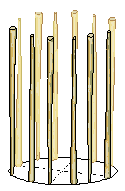 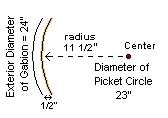 With
the circle adequately marked, the circumference was divided into as many
equal arcs as there were pickets. The number of pickets used largely depended
on the diameter of the material: when the pickets were fairly thick (say
about an inch) nine or ten were used, when thinner (1/2 to 3/4 inch) 10 to
14 pickets were used to make the gabion. To mark the arcs the circle would
be divided into four quarters by two perpendicular diameters and each quarter
further subdivided by the number of pickets needed in each quarter. A gabion
made using 12 pickets, for example, would have four pickets placed on the
circumference of the circle at each quarter mark and each quarter would be
divided into three equal arcs and pickets placed at the arc markers, with
each quarter containing two pickets. With
the circle adequately marked, the circumference was divided into as many
equal arcs as there were pickets. The number of pickets used largely depended
on the diameter of the material: when the pickets were fairly thick (say
about an inch) nine or ten were used, when thinner (1/2 to 3/4 inch) 10 to
14 pickets were used to make the gabion. To mark the arcs the circle would
be divided into four quarters by two perpendicular diameters and each quarter
further subdivided by the number of pickets needed in each quarter. A gabion
made using 12 pickets, for example, would have four pickets placed on the
circumference of the circle at each quarter mark and each quarter would be
divided into three equal arcs and pickets placed at the arc markers, with
each quarter containing two pickets.
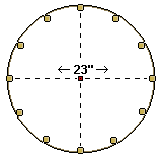 The
pickets were then driven about six inches into the ground along the interior
side of the circumference of the circle in an upright position. When the
pickets were not a uniform diameter along their entire length, which was
usual for such slight material, the thick and thin ends were alternated along
the circumference so that when the thick end of one picket was uppermost
it would be flanked by two pickets with their thin ends uppermost. In cases
in which several pickets were significantly thicker than the others, these
were placed at equal distances from each other and the thinner pickets placed
in their appropriate positions between them. The
pickets were then driven about six inches into the ground along the interior
side of the circumference of the circle in an upright position. When the
pickets were not a uniform diameter along their entire length, which was
usual for such slight material, the thick and thin ends were alternated along
the circumference so that when the thick end of one picket was uppermost
it would be flanked by two pickets with their thin ends uppermost. In cases
in which several pickets were significantly thicker than the others, these
were placed at equal distances from each other and the thinner pickets placed
in their appropriate positions between them.
 Once
the pickets were properly positioned and well driven into the ground, work
on the web could begin. Weaving the web properly required some experience
in basket making; the quality of the web fundamentally determined the quality
and sturdiness of the gabion itself: a well woven gabion could withstand
the rigors of hard use Once
the pickets were properly positioned and well driven into the ground, work
on the web could begin. Weaving the web properly required some experience
in basket making; the quality of the web fundamentally determined the quality
and sturdiness of the gabion itself: a well woven gabion could withstand
the rigors of hard use
 and prolonged
exposed to the elements, a poorly woven gabion would come apart quickly and
be utterly useless of its intended purpose. Several methods that could be
used to weave the web: randing, slewing, pairing, and waling. Randing and
slewing, in which the rods were worked alternately inside and outside of
the pickets (one rod at a time in randing, more than one rod together in
slewing) and prolonged
exposed to the elements, a poorly woven gabion would come apart quickly and
be utterly useless of its intended purpose. Several methods that could be
used to weave the web: randing, slewing, pairing, and waling. Randing and
slewing, in which the rods were worked alternately inside and outside of
the pickets (one rod at a time in randing, more than one rod together in
slewing) 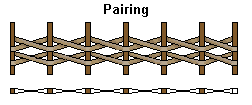 were
considered unsuitable for gabions because the weave was not inter-twined
and produced relatively weak baskets that could be easily damaged or crushed
under normal burdens that gabions were expected to sustain. Pairing, in which
two rods were worked together, passing alternately around each other between
collatera were
considered unsuitable for gabions because the weave was not inter-twined
and produced relatively weak baskets that could be easily damaged or crushed
under normal burdens that gabions were expected to sustain. Pairing, in which
two rods were worked together, passing alternately around each other between
collatera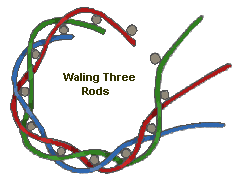 l
pickets, produced a relatively strong gabion quickly and was probably the
most common method used to weave gabion webs. The best, that is, the tightest
and sturdiest, gabions were produced by waling the web. Waling was preformed
by inter-twining three or more rods with each rod passing alternately over
the other two, on the outside of two pickets, under the other two rods and
inside of the next picket. l
pickets, produced a relatively strong gabion quickly and was probably the
most common method used to weave gabion webs. The best, that is, the tightest
and sturdiest, gabions were produced by waling the web. Waling was preformed
by inter-twining three or more rods with each rod passing alternately over
the other two, on the outside of two pickets, under the other two rods and
inside of the next picket.
In all cases the weave started from the ground, where
the the pickets were held firmly in place, and was worked upward. As the
web progressed the pickets tended to compress toward the center of the gabion
circle and had to be held in place by gauge support rods that were placed
near the middle height of the
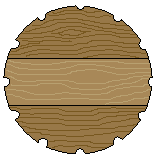 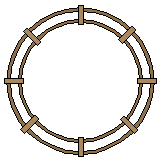 pickets and across the diameter
of the circle. When the web had been worked almost to the level of the support
rods they could be moved up the pickets to maintain the proper diameter.
Other devices could be made, if time allowed, to maintain the diameter such
as notched solid wooden circles and gabion hoops, both of which might save
a little time in making the gabion and could be used to mark the initial
gabion circle on the ground. With each weave around the full diameter of
the gabion the web had to be compressed downward by striking it a firm blow
with a heavy stake or picket. pickets and across the diameter
of the circle. When the web had been worked almost to the level of the support
rods they could be moved up the pickets to maintain the proper diameter.
Other devices could be made, if time allowed, to maintain the diameter such
as notched solid wooden circles and gabion hoops, both of which might save
a little time in making the gabion and could be used to mark the initial
gabion circle on the ground. With each weave around the full diameter of
the gabion the web had to be compressed downward by striking it a firm blow
with a heavy stake or picket.
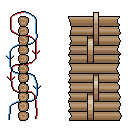 When
the web reached the middle height of the pickets it was bound in place using
strong withes, wire, or heavy string. Binding the gabion web well was just
as important to producing a structurally stable gabion as a good weave: without
a good, tight binding the end rods on the top and bottom would quickly spring
loose from the pickets and cause the gabion to quite literally fall apart
at the seams. To achieve a tight binding the binding material was placed
with its mid-point on the lower edge of the half-completed gabion and either
end was woven upward through the rods, generally passing between two or three
rods. Each time the binding passed through the web the material was drawn
tight and passed through the web again until the upper weave was reached
where the binding material was firmly tied together. In some cases this binding
procedure was not initiated until the gabion had been completed to its full
height and When
the web reached the middle height of the pickets it was bound in place using
strong withes, wire, or heavy string. Binding the gabion web well was just
as important to producing a structurally stable gabion as a good weave: without
a good, tight binding the end rods on the top and bottom would quickly spring
loose from the pickets and cause the gabion to quite literally fall apart
at the seams. To achieve a tight binding the binding material was placed
with its mid-point on the lower edge of the half-completed gabion and either
end was woven upward through the rods, generally passing between two or three
rods. Each time the binding passed through the web the material was drawn
tight and passed through the web again until the upper weave was reached
where the binding material was firmly tied together. In some cases this binding
procedure was not initiated until the gabion had been completed to its full
height and
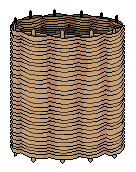 each half
was tied separately and the upper and lower binding materials were then tied
together. In all cases there were supposed to be at least four bindings used
on each half with one passing around the end of the rods of the initial weave. each half
was tied separately and the upper and lower binding materials were then tied
together. In all cases there were supposed to be at least four bindings used
on each half with one passing around the end of the rods of the initial weave.
Once the web was completed to its full height of 2'
9" and both halves firmly bound, the upper pickets were cut off into points
one to three inches above the web. The nearly finished gabion was then pulled
out of the ground (when the gabion was tied after completion of the full
web, the lower half would be bound at this point) and the opposite ends of
the pickets were also cut into points using a hand-saw or hatchet. With this
final pruning of the pickets the gabion would be complete and ready for service.

Revetment of an Interior Slope
D. H. Mahan's Treatise on Field Fortification (1861) indicates that
gabions were rarely used as revetment material except in siege works where
troops had to gain the cover of their work very quickly. Photographic evidence
used in the development of this Detailed Note seems to confirm that gabions
were widely used, but rarely used for the revetment of sustained stretches
of interior slope in regular field works. Some few exceptions to this general
conclusion can be found. Fort Sedgwick in the Federal lines of circumvallation
at Petersburg periodically sustained serious damage to
its parapets
from Confederate bombardments which was repaired using gabions as revetment
material. In this case repairs had to be made quickly in the dark; gabions
were easy to handle and did allow the fort's parapets to be raised relatively
quickly with a minimum of extraneous labor. After Fort Sumter was destroyed
as a masonry fortification it was converted into a very strong field work
by applying gabion revetments to the interior walls of the fort. parapets
from Confederate bombardments which was repaired using gabions as revetment
material. In this case repairs had to be made quickly in the dark; gabions
were easy to handle and did allow the fort's parapets to be raised relatively
quickly with a minimum of extraneous labor. After Fort Sumter was destroyed
as a masonry fortification it was converted into a very strong field work
by applying gabion revetments to the interior walls of the fort.
 For
regular field works a gabion revetment was constructed by laying a course
of gabions along the line of the foot of the interior crest as soon as the
parapet had been raised to the level of the banquette tread. This first course
could be given an appropriate inclination (to follow the intended angle of
the interior slope) by burying a fascine at the foot the interior and laying
the gabion on the fascine. In other cases gabions could be laid on the surface
of the forming parapet and their projecting pickets driven into the ground
to firmly anchor them in place. Once filled with earth, a course of fascines
or timber was laid lengthwise along the inside edge of the gabions to both
raise the cover a bit more quickly and cap the gabions securely together,
which also helped maintain a neat line for the interior slope. In those cases
in which the interior slope was not graced by the presence of a banquette
a second course of gabions was added on top of the course of fascines. For
regular field works a gabion revetment was constructed by laying a course
of gabions along the line of the foot of the interior crest as soon as the
parapet had been raised to the level of the banquette tread. This first course
could be given an appropriate inclination (to follow the intended angle of
the interior slope) by burying a fascine at the foot the interior and laying
the gabion on the fascine. In other cases gabions could be laid on the surface
of the forming parapet and their projecting pickets driven into the ground
to firmly anchor them in place. Once filled with earth, a course of fascines
or timber was laid lengthwise along the inside edge of the gabions to both
raise the cover a bit more quickly and cap the gabions securely together,
which also helped maintain a neat line for the interior slope. In those cases
in which the interior slope was not graced by the presence of a banquette
a second course of gabions was added on top of the course of fascines.
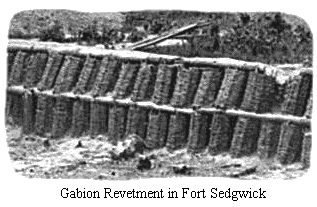 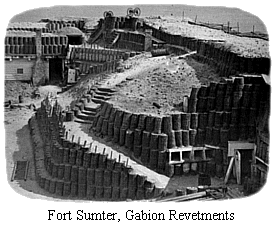
[This page originally appeared as a Detailed Notes Page on
the old Civil War Field Fortifications Website.] |